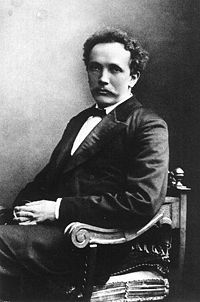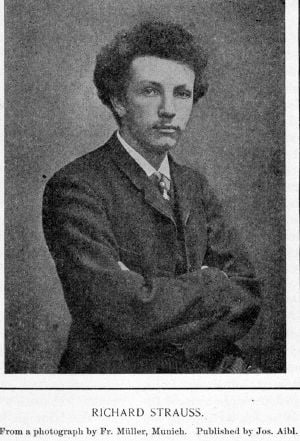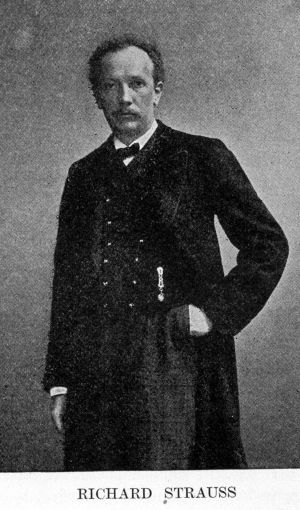Difference between revisions of "Richard Strauss" - New World Encyclopedia
Cheryl Lau (talk | contribs) |
Cheryl Lau (talk | contribs) (importing credit and version numbers) |
||
| Line 158: | Line 158: | ||
[[Categories: Art, music, literature, sports and leisure]] | [[Categories: Art, music, literature, sports and leisure]] | ||
| − | {{credit| | + | {{credit|84846453}} |
Revision as of 20:25, 7 November 2006
- This article is about the German composer of tone-poems and operas. For the Viennese composers noted for waltzes and polkas, see the Strauss family.
Richard Strauss (June 11, 1864 – September 8, 1949) was a German composer of the late Romantic era, particularly noted for his tone poems and operas. He was also a noted conductor.
History
Early life
He was born on June 11, 1864, in Munich (then in the Kingdom of Bavaria, now in Germany), the son of Franz Strauss, who was the principal horn player at the Court Opera in Munich. He received a thorough, but conservative, musical education from his father in his youth, writing his first music at the age of six. He continued to write music almost until his death.
During his boyhood he had the good fortune to be able to attend orchestra rehearsals of the Munich Court Orchestra, and he also received private instruction in music theory and orchestration from an assistant conductor there. In 1874 Strauss heard his first Wagner operas, Lohengrin, Tannhäuser and Siegfried; the influence of Wagner's music on Strauss's style was to be profound, but at first his father forbade him to study it: it was not until the age of 16 that he was able to obtain a score of Tristan und Isolde. Indeed, in the Strauss household the music of Richard Wagner was considered inferior. Later in life, Richard Strauss said and wrote that he deeply regretted this.
In 1882 he entered Munich University, where he studied philosophy and art history — not music — however he left a year later to go to Berlin. There he studied briefly before securing a post as assistant conductor to Hans von Bülow taking over from him at Munich when he resigned in 1885. His compositions around this time were quite conservative, in the style of Robert Schumann or Felix Mendelssohn, true to his father's teachings. His Horn Concerto No. 1 (1882 – 1883) is representative of this period and is still regularly played. Strauss's style began to change when he met Alexander Ritter, a noted composer and violinist, and the husband of one of Richard Wagner's nieces. It was Ritter who persuaded Strauss to abandon the conservative style of his youth, and begin writing tone poems; he also introduced Strauss to the essays of Richard Wagner and the writings of Schopenhauer. Strauss went on to conduct one of Ritter's operas, and later Ritter wrote a poem based on Strauss's own Tod und Verklärung.
Richard Strauss married soprano singer Pauline Maria de Ahna on September 10, 1894. She was famous for being bossy, ill-tempered, eccentric, and outspoken, but the marriage was happy, and she was a great source of inspiration to him. Throughout his life, from his earliest songs to the final Four Last Songs of 1948, he always preferred the soprano voice above all others.
Tone poems
This newly found interest resulted in what is widely regarded as Strauss' first piece to show his mature personality, the tone poem Don Juan. When this was premiered in 1889, half of the audience cheered while the other half booed. Strauss knew he had found his own musical voice, saying "I now comfort myself with the knowledge that I am on the road I want to take, fully conscious that there never has been an artist not considered crazy by thousands of his fellow men." Strauss went on to write a series of other tone poems, including Aus Italien (1886), Tod und Verklärung (Death and Transfiguration, 1888 – 89), Till Eulenspiegels lustige Streiche (Till Eulenspiegel's Merry Pranks, 1894 – 95), Also sprach Zarathustra (Thus Spoke Zarathustra, 1896, the opening section of which is well known today for its use in Stanley Kubrick's film 2001: A Space Odyssey), Don Quixote (1897), Ein Heldenleben (A Hero's Life, 1897 – 98), Sinfonia Domestica (Domestic Symphony 1902 – 03) and Eine Alpensinfonie (An Alpine Symphony 1911 – 15).
Opera
Around the end of the 19th century, Strauss turned his attention to opera. His first two attempts in the genre, Guntram in 1894 and Feuersnot in 1901 were critical failures. However, in 1905 he produced Salome (based on the play by Oscar Wilde), and the reaction was as passionate and extreme as it had been with Don Juan. When it opened at the Metropolitan Opera in New York City, there was such a public outcry that it was closed after just one performance. Doubtless, much of this was due to the subject matter, and negative publicity about Wilde's "immoral" behavior. However, some of the negative reactions may have stemmed from Strauss's use of dissonance, rarely heard then at the opera house. Elsewhere the opera was highly successful and Strauss financed his house in Garmisch-Partenkirchen completely from the revenues generated by the opera.
Strauss' next opera was Elektra, which took his use of dissonance even further. It was also the first opera in which Strauss collaborated with the poet Hugo von Hofmannsthal. The two would work together on numerous other occasions. For these later works, however, Strauss moderated his harmonic language somewhat, with the result that works such as Der Rosenkavalier (The Knight of the Rose, 1910) were great public successes. Strauss continued to produce operas at regular intervals until 1940. These included Ariadne auf Naxos (1912), Die Frau ohne Schatten (1918), Intermezzo (1923), Die ägyptische Helena (1927), and Arabella (1932), all in collaboration with Hofmannsthal; and Die schweigsame Frau (1934), with Stefan Zweig as librettist; Friedenstag (1936) and Daphne (1937) (libretto by Joseph Gregor and Zweig); Die Liebe der Danae (1940) (with Gregor) and Capriccio (libretto by Clemens Krauss) (1941).
Solo and chamber works
Strauss's solo and chamber works include early compositions for piano solo in a conservative harmonic style, many of which are lost; a rarely-heard string quartet (opus 2); the famous violin sonata in Eb which he wrote in 1887; as well as a handful of late pieces. There are only six works in his entire output dating from after 1900 which are for chamber ensembles, and four are arrangements of portions of his operas. His last chamber work, an Allegretto in E for violin and piano, dates from 1940.
Solo instrument with orchestra
Much more extensive was his output of works for solo instrument or instruments with orchestra. The most famous include two horn concerti which are still part of the standard repertoire of most french horn soloists, a concerto for violin, Burleske for Piano and Orchestra, the tone poem Don Quixote, for cello, viola and orchestra, a late concerto for oboe (inspired by a request from an American soldier and oboist, John DeLancie, whom he met after the war), and the duet concertino for bassoon and clarinet, which was one of his last works (1947). Strauss admitted that the duet concertino had an extra-musical "plot", in which the clarinet represented a princess and the bassoon a bear; when the two dance together, the bear transforms into a prince.
Strauss and the Nazis
There is much controversy surrounding Strauss' role in Germany after the Nazi Party came to power. Some say that he was constantly apolitical, and never cooperated with the Nazis completely. Others point out that he was an official of the Third Reich. Several noted musicians disapproved of his conduct while the Nazis were in power, among them the conductor Arturo Toscanini, who famously said, "To Strauss the composer I take off my hat; to Strauss the man I put it back on again."
In November 1933, without any consultation with Strauss, Goebbels appointed him to the post of president of the Reichsmusikkammer, the State Music Bureau. Strauss decided to keep his post but to remain apolitical, a decision which has been criticized as naïve, but perhaps the most sensible one considering the circumstances. While in this position he wrote and conducted the Olympic Hymn for the 1936 Olympics, and also befriended some highly-ranked Nazis. Evidently his intent was to protect his daughter-in-law Alice, who was Jewish, from persecution. In 1935, Strauss was forced to resign his position as Reichsmusikkammer president, after refusing to remove from the playbill for Die schweigsame Frau the name of the Jewish librettist, his friend Stefan Zweig. He had written Zweig a supportive letter, insulting to the Nazis, which was intercepted by the Gestapo.
His decision to produce Friedenstag in 1938, a one-act opera set in a besieged fortress during the Thirty Years' War – essentially a hymn to peace and a thinly veiled criticism of the Third Reich – during a time when an entire nation was preparing for war, has been seen as extraordinarily brave. With its contrasts between freedom and enslavement, war and peace, light and dark, this work has been considered more related to Fidelio than to any of Strauss's other recent operas. Production ceased on the outbreak of war in 1939.
When his daughter-in-law Alice was placed under house arrest in Garmisch in 1938, Strauss used his connections in Berlin, for example the Berlin Intendant Heinz Tietjen, to secure her safety; in addition, there are also suggestions that he attempted to use his official position to protect other Jewish friends and colleagues. Unfortunately Strauss left no specific records or commentary regarding his feeling about Nazi Anti-Semitism, so most of the reconstruction of his motivations during the period are conjectural. While most of his actions during the 1930s were midway between outright collaboration and dissidence, it was only in his music that the dissident streak was, in retrospect, more obvious, such as in the pacifist drama Friedenstag.
In 1942 Strauss moved with his family back to Vienna, where Alice and her children could be protected by Baldur von Schirach, the Gauleiter of Vienna. Unfortunately even he was unable to protect Strauss's Jewish relatives completely; in early 1944, while Strauss was away, Alice and the composer's son were abducted by the Gestapo and imprisoned for two nights. Only Strauss's personal intervention at this point was able to save them, and he was able to take the two of them back to Garmisch, where they remained, under house arrest, until the end of the war.
Strauss completed the composition of Metamorphosen, a work for 23 solo strings, in 1945. The piece mourned the destruction of Germany wrought by World War II, but also encouraged the continued examination of Strauss's sympathy for Nazi Germany. It is now generally accepted that Metamorphosen was composed, specifically, to mourn the bombing of Strauss's favorite opera house; and generally, to reflect on the damage caused by the war to the German culture and aesthetic.
He was later tried and absolved of any Nazi ties or affiliations.
The final years
In 1948, Strauss wrote his last work, Vier letzte Lieder ("Four last songs") for soprano and orchestra, reportedly with Kirsten Flagstad in mind. She certainly gave the first performance (live) and it was recorded, but the quality is poor. It is available as an historic CD release for enthusiasts. All his life he had produced lieder, but these are among his best known (alongside "Zueignung", "Cäcilie", "Morgen" and "Allerseelen"). When compared to the work of younger composers, Strauss' harmonic and melodic language was looking somewhat old-fashioned by this time. Nevertheless, the songs have always been popular with audiences and performers. Strauss himself declared in 1947, "I may not be a first-rate composer, but I am a first-class second-rate composer!"
Richard Strauss died on September 8, 1949, in Garmisch-Partenkirchen, Germany at the age of 85.
Principal works
Tone poems
- Aus Italien (1886)
- Macbeth (1888/90)
- Don Juan (1889)
- Tod und Verklärung (Death and Transfiguration) (1891)
- Till Eulenspiegels lustige Streiche (Till Eulenspiegel's Merry Pranks) (1895)
- Also sprach Zarathustra (1896)
- Don Quixote (1898)
- Ein Heldenleben (1899)
- Symphonia Domestica (Domestic Symphony) (1904)
- Eine Alpensinfonie (An Alpine Symphony) (1915)
Other orchestral works
- Symphony in D minor (1880)
- Concerto in D minor for violin and orchestra, op. 8 (1882)
- Concerto No. 1 for horn and orchestra in E flat major (1882/83)
- Symphony in F minor, op. 12 (1883)
- Burleske for Piano and Orchestra (1886-1890)
- Festive Prelude for orchestra and organ (1913)
- Le Bourgeois gentilhomme suite for orchestra (1917)
- Festive Japanese Music (1940)
- Concerto No. 2 for horn and orchestra in E flat major (1942)
- Concerto for Oboe (1945)
- Double Concertino for clarinet and oboe and orchestra (1947)
- Film music for Der Rosenkavalier (1925)
Operas
- Guntram (1894)
- Feuersnot (1901)
- Salome (1905)
- Elektra (1909)
- Der Rosenkavalier (The Knight of the Rose) (1910)
- Ariadne auf Naxos (1912)
- Die Frau ohne Schatten (1918)
- Intermezzo (1923)
- Die ägyptische Helena (The Egyptian Helena) (1927)
- Arabella (1932)
- Die schweigsame Frau (The Silent Woman) (1934)
- Friedenstag (Day of Peace) (1936)
- Daphne (1937)
- Die Liebe der Danae (1940)
- Capriccio (1941)
Ballet music
- Josephslegende (The Legend of Joseph) (1914)
- Crême chantilly (Schlagobers) (1924)
Choir works
- Zwei Gesänge, op. 34 (1896/97) - 1. Der Abend 2. Hymne
- Deutsche Motette, op. 62 (1913)
- Die Göttin im Putzzimmer (1935)
- Männerchöre (1935)
- An den Baum Daphne (1943)
Other works
- Metamorphosen for 23 solo strings (1945)
- Vier letzte Lieder (Four Last Songs) (1948)
Sources
- Michael Kennedy, "Richard Strauss," The New Grove Dictionary of Music and Musicians, ed. Stanley Sadie. 20 vol. London, Macmillan Publishers Ltd., 1980. ISBN 1-56159-174-2
- Bryan Gilliam: "Richard Strauss", Grove Music Online ed. L. Macy (Accessed August 19, 2005), (subscription access) (This article is very different from the one in the 1980 Grove; in particular, the analysis of Strauss's behavior during the Nazi period is more detailed.)
- David Dubal, "The Essential Canon of Classical Music," North Point Press, 2003. ISBN 0-86547-664-0
Selective Bibliography
- Del Mar, Norman (1962). Richard Strauss. London: Barrie & Jenkins. ISBN 0-214-15735-0.
- Gilliam, Bryan (1999). The Life of Richard Strauss. Cambridge: Cambridge University Press. ISBN 0-521-57895-7.
- Kennedy, Michael (1999). Richard Strauss: Man, Musician, Enigma. Cambridge: Cambridge University Press. ISBN 0-521-58173-7.
- Osborne, Charles (1991). The Complete Operas of Richard Strauss. New York City: Da Capo Press. ISBN 0-306-80459-X.
- Wilhelm, Kurt (1989). Richard Strauss: An Intimate Portrait. London: Thames & Hudson. ISBN 0-500-01459-0.
- Youmans, Charles (2005). Richard Strauss's Orchestral Music and the German Intellectual Tradition: the Philosophical Roots of Musical Modernism. Bloomington: Indiana University Press. ISBN 0-253-34573-1.
See also:
- Category:Compositions by Richard Strauss
External links
- Chronological list of Strauss's works
- Richard Strauss online
- Public Domain Sheet Music of Richard Strauss at IMSLP
| Preceded by: Hermann Levi |
General Music Directors, Bavarian State Opera 1894 – 1896 |
Succeeded by: Hermann Zumpe |
| Romanticism | |
|---|---|
| Eighteenth century - Nineteenth century | |
| Romantic music: Beethoven - Berlioz - Brahms - Chopin - Grieg - Liszt - Puccini - Schumann - Tchaikovsky - The Five - Verdi - Wagner | |
| Romantic poetry: Blake - Burns - Byron - Coleridge - Goethe - Hölderlin - Hugo - Keats - Lamartine - Leopardi - Lermontov - Mickiewicz - Nerval - Novalis - Pushkin - Shelley - Słowacki - Wordsworth | |
| Visual art and architecture: Brullov - Constable - Corot - Delacroix - Friedrich - Géricault - Gothic Revival architecture - Goya - Hudson River school - Leutze - Nazarene movement - Palmer - Turner | |
| Romantic culture: Bohemianism - Romantic nationalism | |
| << Age of Enlightenment | Victorianism >> Realism >> |
| Persondata | |
|---|---|
| NAME | Strauss, Richard |
| ALTERNATIVE NAMES | |
| SHORT DESCRIPTION | German composer and conductor |
| DATE OF BIRTH | 11 June 1864 |
| PLACE OF BIRTH | Munich, Bavaria |
| DATE OF DEATH | 8 September 1949 |
| PLACE OF DEATH | Garmisch-Partenkirchen, Germany |
Categories: Art, music, literature, sports and leisure
Credits
New World Encyclopedia writers and editors rewrote and completed the Wikipedia article in accordance with New World Encyclopedia standards. This article abides by terms of the Creative Commons CC-by-sa 3.0 License (CC-by-sa), which may be used and disseminated with proper attribution. Credit is due under the terms of this license that can reference both the New World Encyclopedia contributors and the selfless volunteer contributors of the Wikimedia Foundation. To cite this article click here for a list of acceptable citing formats.The history of earlier contributions by wikipedians is accessible to researchers here:
The history of this article since it was imported to New World Encyclopedia:
Note: Some restrictions may apply to use of individual images which are separately licensed.



